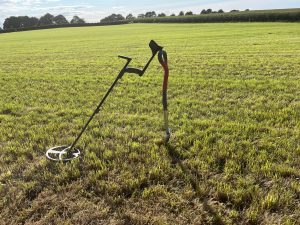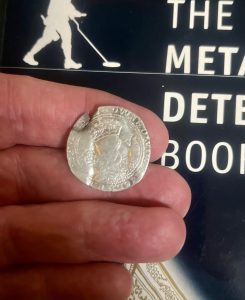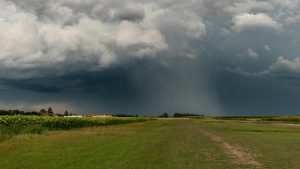
It was an early July Saturday when we ventured out to a permission on the border between the counties of Cheshire and Derbyshire. The views out here are dramatic and far reaching.

This permission consists of two farms with maybe 150 acres between them. Historically a lot had happened in this part of the country, there were iron age and bronze age trackways and burial mounds, there were old droving routes and paths, but so far we hadn’t found much out here. The ground was soft and we were getting the impression that this combination of soft ground and thousands of years of cultivation had resulted in all but the newest of losses being too far down for us to find. This was backed up by me finding a Queen Victoria sixpence at over 30cm down. I’m surprised that I found that but somehow I did.
On this particular occasion we decided to try a new field just behind the farmhouse, the farmers wife had told us about a couple of Georgian silver coins being found in this area some years ago. As we ventured into the field, the farmer, Geoff, suddenly fired off both barrels of his shotgun at some rooks that were nesting in one of the barns. We instinctively ducked, and from that day on, we always refer to this field as the Shotgun Field.
We set up our metal detectors, me using my trusty XP ORX and Bob was using his XP Deus. The ground seemed to be firmer than other fields that we had tried and sure enough we started to find a few coins and buttons, nothing particularly old, but at least we were finding things. I decided to focus on a gentle slope at the bottom end of the field. I was getting a few diggable signals, but again mostly toasted unidentifiable coins, probably George II or III.
I then got another diggable signal and carefully took out a roundish clod of turf and soil, maybe 8 inches deep. On checking with my metal detector, whatever it was, was still in the hole. I soon located it with my pinpointer and after loosening the soil slightly spotted a copper disc. It was worn and slightly fragile looking, but I could make out some sort of animal on one side, and another on the other side. It looked like a coin, but definitely wasn’t one. It was some sort of copper trade token, but not one that I had ever seen before. I showed it to Bob and placed it in my coin pod for further investigation later. The rest of our detecting day revealed nothing much more. Bob found a spill of sixpences alongside a wall, maybe five of them fairly close to each other, but they weren’t particularly old, dating from the 1930’s and 1940’s. After a good full afternoon’s detecting, we decided to call it a day and head to the pub for a couple of beers before heading home.
Once I was home I was able to start a gentle cleaning of this particular find. It was a bit fragile with clear flaking to the edges around the circumference, visible on both sides. Slowly some of the detail emerged but it was quite worn, but at least I could now make out some of the detail.
One side featured a rhinoceros with the word Pidcock above it, below it I could make out Exeter Exchange London. On the other side was a two headed cow with the words Exeter Exchange Strand London.

It didn’t take me long to do a little bit of research to find out that Gilbert Pidcock owned an exotic animal menagerie that was based in Exeter Exchange on the Strand in London. This was from around 1794 into the early 1800’s. He would also travel around the country displaying his collection of animals.
In 1799 the following newspaper report was published,:
“Yesterday arrived, and are to be seen for a few days only, on Lady Wootton’s Green, the grandest assemblage of ‘Foreign Birds & Beasts’ from the four quarters of the globe, the property of G. Pidcock, from his Grand Menagery, Exeter Exchange, Strand, London, drawn by twenty horses, in four magnificent caravans, valued at five thousand pounds.
They chiefly consist of the ‘Rhinoceros’ or real ‘Unicorn’. This most singular of all quadrupeds, when full grown, is at least twelve feet long. The Rhinoceros, which was brought to London in the year 1739, was sent from Bengal, though not above two years of age, the expense of his food amounted to near one thousand pounds sterling. This surprising animal is covered with an impenetrable coat of mail, there is when fully grown, a sharp pointed horn growing out of his forehead, measuring from eighteen to twenty inches in length… Admittance One Shilling each.“
Earlier in 1794 was this:
“To the curious observers of natural phenomena… To be sold. That most wonderful production of the creation, the Heifer with two heads, alive, which has given such universal satisfaction to the curious in London and chiefly through England, is now at Chester, and was intended to have been taken, over to Dublin, as she has never been there yet, by desire of many respectable ladies and gentlemen; but the proprietor’s ill state of health prevents it: And in order to oblige the inhabitants of Dublin, he purposes selling her to any person whom she might suit. She is allowed by most naturalists to be the most extraordinary phenomena of Nature ever known. She has two perfect heads, four horns, four ears, four eyes and four nostrils (through each of which it breathes) Enquire G. Pidcock, at the Swan With Two Necks inn, back of the Exchange, Chester.“
So in 1794 Gilbert Pidcock was on tour traveling through Cheshire on his way to Ireland and became ill so decided to sell his two headed heiffer. By 1799 there was no mention of the two headed heiffer. So presumably he sold it, probably in Cheshire. It sounds like he set up his menagerie on route and charged an admission fee.
Maybe the field behind the house in Cheshire was one of these places where he displayed his animals as he passed through Cheshire?
Well who knows but it is an interesting metal detecting find, with a story of its own to tell. I love finding things that have a story to tell.
More about Pidcock’s Menagerie
Pidcock’s Menagerie was an early and renowned traveling menagerie or zoo established by a man named Gilbert Pidcock. This menagerie gained popularity in the 18th and 19th centuries and provided people in various locations the opportunity to view a diverse collection of exotic animals from around the world.
Here are some key points about Pidcock’s Menagerie:
- Founder: Gilbert Pidcock, born in 1754, was an Englishman who established Pidcock’s Menagerie. He had a keen interest in natural history and began collecting and exhibiting animals.
- Formation of the Menagerie: Pidcock’s Menagerie was established in the late 18th century, around the 1790s. The collection initially included a wide array of animals, ranging from lions and tigers to more unusual creatures such as kangaroos and zebras.
- Traveling Exhibition: Pidcock’s Menagerie was not a fixed zoo but rather a traveling exhibition that moved from place to place. It visited various cities and towns, attracting crowds eager to witness the exotic animals, many of which were rarely seen in England at that time.
- Exotic Animals: The menagerie featured animals from different continents, brought to England through trade routes and exploratory voyages. The exhibition aimed to provide the public with a glimpse of the world’s diverse fauna.
- London and International Exhibitions: While Pidcock’s Menagerie primarily traveled around England, it also had a presence in London, where it attracted both local residents and visitors from abroad. Pidcock even exhibited his collection in Paris for a period.
- Influence and Legacy: Pidcock’s Menagerie contributed to the growing interest in natural history and exotic animals during the Age of Enlightenment. The menagerie format became a precursor to the modern concept of zoos.
- Later Years: Gilbert Pidcock passed away in 1810, but the menagerie continued to operate under his son, Thomas Pidcock. It eventually faced financial difficulties and was sold in 1839.
Pidcock’s Menagerie is remembered as an important cultural phenomenon of its time, offering people a chance to marvel at the wonders of the natural world. The concept of traveling menageries influenced the development of zoos as educational and entertainment institutions.




